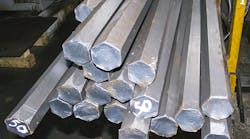Engineers often specify steel when designing axles, bearings, shafts, gears, and a host of other components essential to the dependability and safety of both consumer and industrial products. But many of these engineers overlook specification practices that can lower the cost of steel parts. Here are eight tips that can lead to stronger, lighter, and less expensive parts and products:
Specify cold finishing. Cold finishing increases a metal’s tensile, yield, and torsional strength, as well as its hardness and wear resistance. It also improves the finish, dimensional accuracy, and machinability, all at a nominal cost increase. This means cold-drawn carbon-steel bar can often be used instead of a more expensive alloy, or a low-cost alloy substituted for a more expensive grade.
Consider HSLA. High-strength, low-alloy steels (HSLA) cost less than full-alloy grades of equivalent yield strength and require no strengthening heat treatments in the mill or by users. This means they can be used to make lighter parts with no cost penalty.
Add surface carbon. The wear resistance of parts made from low-carbon-steel bar can be boosted by increasing the carbon content in the parts’ surface area, followed by heat treatment. Carbon is added through carburization, which involves furnace-treating parts at a high temperature in a carbon-rich atmosphere. Grades of steel most commonly carburized include AISI 1015, 1018, 1020, and 1117.
Use mill pretreatments. Heat treating bar steel at the mill is almost always less expensive than heat treating finished parts. This cost-saving alternative is feasible when subsequent manufacturing operations do not involve reheating the steel to above its transformation temperature. Another advantage of avoiding heat treatments after parts are formed or machined is the elimination of potential problems such as cracking, distortion, and decarburization.
Specify special-quality steel bars. Using preheat-treated bars lets companies invest more in materials to simplify plant production processes and cut post-production costs. An example of this approach is the increasing use of special-quality bar steel which is made and conditioned to meet the exacting requirements of specific application or fabrication methods. Other examples include shaft-quality and rod-extrusion-quality bars.
Shape it hot and fast… Automatic hot-forging equipment accepts mill-length steel bars at one end and turns out precision hot-forged parts at the other. The bar is induction heated in seconds, goes through a three- or four-stage die series, and emerges as individual forged parts at rates as high as 180 parts/min. Another hot-forming process, extrusion, shapes full-length steel bars though dies to yield material and fabrication savings. Some processors take advantage of the heat content of the emerging extruded parts or shapes, putting them immediately through a heat-treatment cycle.
…or shape it cold. Parts can be chiplessly formed cold to shapes close to the final form to save on energy costs. Cold heading, extrusion, and draw-shaping could save up to 25% in material costs over screw-machine operations. And cold heading, for some arts, is faster than forging.
Be smart when buying. Purchasing and in-plant handling operations can also be adjusted to lower the cost of parts made from steel bar. For example, longer production runs and less handling become possible if the bar can be used in coils rather than cut bar form. Large coils also often improve the efficiency of annealing and leaning operations. Similarly ordering bar steel in large bundles reduces the per-pound handling fees. Other packaging practices should also be examined. “Extras” such as paper overwraps, skids, crating, color marking, and stamping of batch numbers or grade add to the cost of the steel.
